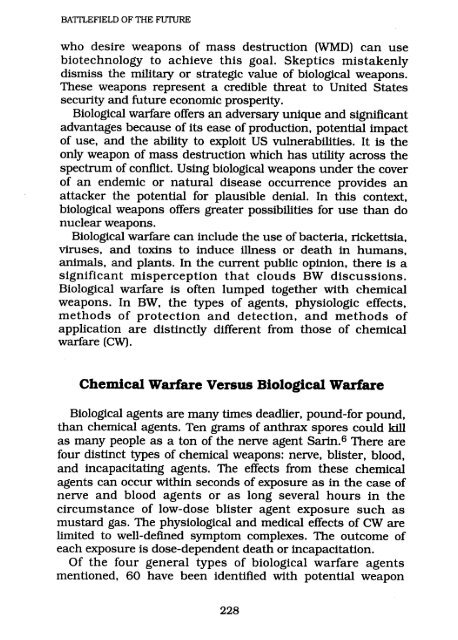BATTLEFIELD OF THE FUTURE
Battlefield of the Future - Air University Press
Battlefield of the Future - Air University Press
Create successful ePaper yourself
Turn your PDF publications into a flip-book with our unique Google optimized e-Paper software.
<strong>BATTLEFIELD</strong> <strong>OF</strong> <strong>THE</strong> <strong>FUTURE</strong><br />
who desire weapons of mass destruction (WMD) can use<br />
biotechnology to achieve this goal . Skeptics mistakenly<br />
dismiss the military or strategic value of biological weapons.<br />
These weapons represent a credible threat to United States<br />
security and future economic prosperity .<br />
Biological warfare offers an adversary unique and significant<br />
advantages because of its ease of production, potential impact<br />
of use, and the ability to exploit US vulnerabilities . It is the<br />
only weapon of mass destruction which has utility across the<br />
spectrum of conflict . Using biological weapons under the cover<br />
of an endemic or natural disease occurrence provides an<br />
attacker the potential for plausible denial . In this context,<br />
biological weapons offers greater possibilities for use than do<br />
nuclear weapons .<br />
Biological warfare can include the use of bacteria, rickettsia,<br />
viruses, and toxins to induce illness or death in humans,<br />
animals, and plants . In the current public opinion, there is a<br />
significant misperception that clouds BW discussions .<br />
Biological warfare is often lumped together with chemical<br />
weapons . In BW, the types of agents, physiologic effects,<br />
methods of protection and detection, and methods of<br />
application are distinctly different from those of chemical<br />
warfare (CW) .<br />
Chemical Warfare Versus Biological Warfare<br />
Biological agents are many times deadlier, pound-for pound,<br />
than chemical agents . Ten grams of anthrax spores could kill<br />
as many people as a ton of the nerve agent Sarin.s There are<br />
four distinct types of chemical weapons : nerve, blister, blood,<br />
and incapacitating agents . The effects from these chemical<br />
agents can occur within seconds of exposure as in the case of<br />
nerve and blood agents or as long several hours in the<br />
circumstance of low-dose blister agent exposure such as<br />
mustard gas . The physiological and medical effects of CW are<br />
limited to well-defined symptom complexes . The outcome of<br />
each exposure is dose-dependent death or incapacitation .<br />
Of the four general types of biological warfare agents<br />
mentioned, 60 have been identified with potential weapon<br />
228

















